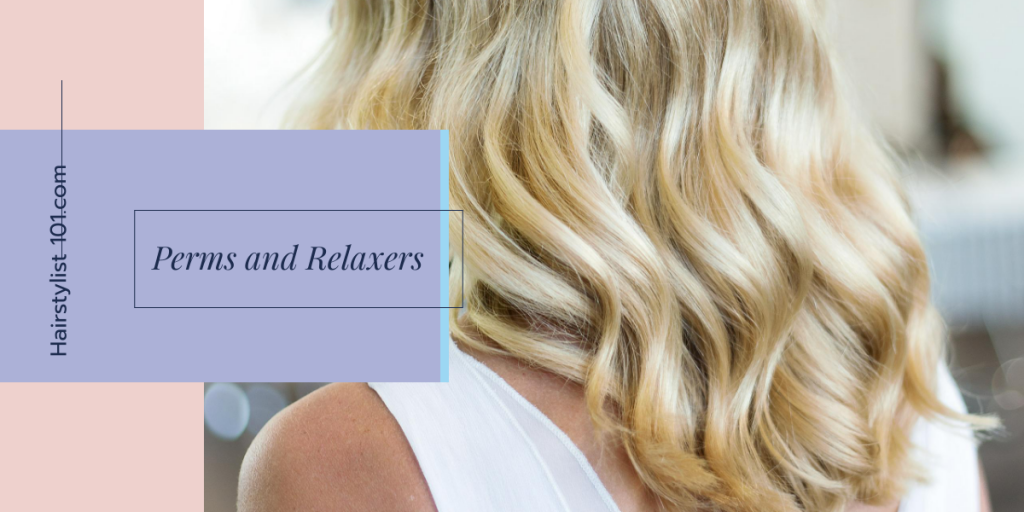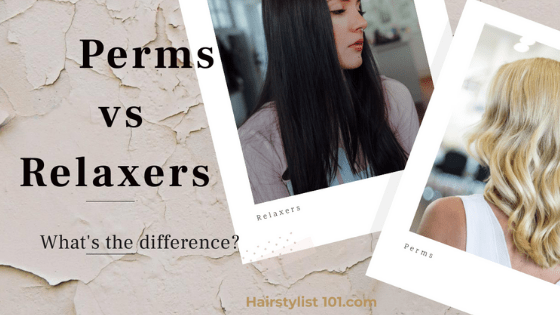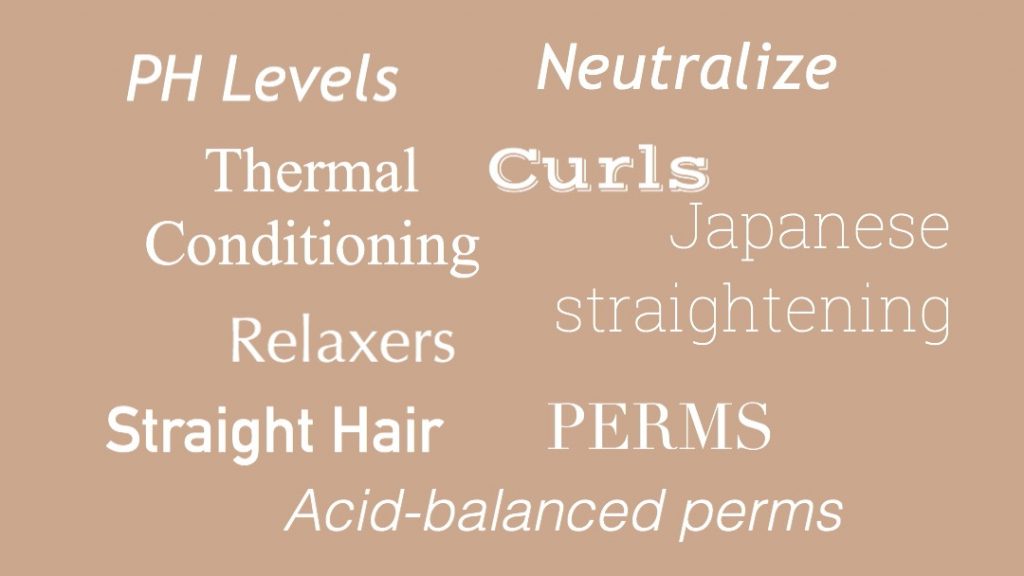Perms are applied to naturally straight hair and the aim is to introduce curls to the hair. The process is achieved by the use of chemicals along with rods and rollers. When the chemical is applied to the hair, the hair takes the shape of the rod and then they are neutralized. Perms make use of ammonium thioglycolate which is also called Theo or thiol. Some perms are meant to be gentle on hair and they use glyceryl monothioglycolate. These are called acid balanced perms.
Relaxer is the permanent hair straightening method. The hair relaxer will stretch the natural curl pattern or tightly curled hair depending on the strength and the timing of the chemical. The relaxer is a creamy paste that gets applied directly on to the hair avoiding the scalp. once you see the results you like, you thoroughly wash out the relaxer and you will apply the neutralizing shampoo. The hair will remain straight until new hair grows out. Relaxers, make use of sodium hydroxide. However, there are some relaxers that might make use of ammonium thioglycolate like perms and just omit rods and rollers that are otherwise used to curl the hair.
The latest technological advancements in the hair industry have taken us all by storm. We already know that different people possess different hair characteristics. You find people with curly hair, straight hair, thin hair, thick hair, and the list continues. The way you describe the look to your salon professional will help to guide them in understanding the type of service you are looking for.
People now have multiple options to transform their natural hair to get the look they want to be performed by working with a licensed cosmetologist.
The hair straightening can also be known as Japanese straightening or thermal reconditioning as well. The product would be strategically placed and process with a heat lamp as per the manufacturer’s directions. As different than a relaxer, the thermal reconditioning will require drying and smoothing the hair with heat irons to seal product before the neutralizer is applied.
Perms and relaxers are two such impressive techniques that help people to achieve the desired look. However, little do people know about these techniques, often find themselves in a fix as to which is the right technique and style for them. For many of them, perms and relaxers are one and the same thing. But they are not the same. They are applied to one’s hair for different purposes and the results that follow are different as well.
Another difference between a relaxer and the perm lies in the procedure applied and the intended outcome. While a perm is used to introduce curls to the hair with the help of plastic curling rods, a relaxer is used to loosen and relax natural curls and waves from the hair. Nevertheless, the chemicals used in both methods are similar in that they work to change the current structure of the hair.
Hair relaxers and perms are trending these days and many salons are providing these services to their clients. Both of these techniques are effective and thus, people are embracing these hair techniques as well. Before you choose any of the treatments for your hair, here are some of the facts that you must know about them.

What you must know about perms and relaxers?
Both techniques make use of chemicals to alter hair. The results differ due to the PH levels of the chemicals used in both the techniques. The re-shaping is largely dependent on the pH level of the chemical used.
Hair Perms
It is very much possible to customize the shape of the hair as per the need of the customer. Depending on length and style a permanent wave can last between 3 months to 6 months. Short hairstyles can last 3 months while longer hair will have longer results. With either one of these shapes, the roots eventually get flat and that’s when a new perm would be needed.
There are many different sizes of rods and rollers to wrap for different curl pattern results. There can be straw sized rods for tight coil curls to silver dollars size rods for a body bounce. There are many sizes in between to fit the look and overall style. Rods and rollers come in a variety of different colors to keep the pattern consistent. Using different rod sizes can make tighter or looser curls where ever you may need them
Hair is sectioned in wide but thin sections wrapping wet hair winding from tips to roots. Endpapers will aid you in getting clean sections on to the rod. This ensures uneven hair cuts can be wound evenly in order for the ends of the hair to have a smooth finish.
Relaxers
As your natural hair grows out and your hair is in need of a touch up.. that is exactly what you will do, touch up the new growth area. People mistakenly think you have to run the relaxer throughout the entire hair shaft. Doing this can lead to breakage and damaged hair. once relaxer is overlapped, it cannot be repaired. With relaxers the longer and heavier the hair is, will prolong the effects of the treatment. Shorter hair or maintained haircuts will eventually have the treated hair cut off resulting in the springing of the curls on the roots.
Having severely damaged or pre-lightened hair can result in severe damage to the hair. The chemicals alter natural and virgin hair evenly, but if the hair is damaged where the porosity of the hair is mismatched the results will be traumatic for the over processed hair. Highlighted or over processed bleached hair can result in breakage and damage can occur as well. Milder options chemicals can be researched as well for special hair. Having highlights or high lift colors on perms or relaxers are not recommended for optimum results.

Detailed differences between perms and relaxers
We have already seen that a perm and a relaxer is applied to the hair for different intended outcomes, and how the chemicals affect the texture. However, ph. levels used in the chemicals differ in both the methods.
When we talk about the mechanical manipulation of the hair, both of these techniques sound similar because both of the technique involves lifting of the outermost layer of the hair strand and break the disulfide bond that helps to alter the natural texture of the hair. This is the point that will decide the future shape of the hair. The hair specialist or the cosmetologist will know how to hold the hair at this stage to achieve the desired outcome.
In perm, the stylist will wrap the hair around the rods and rollers while in the relaxer, the stylist will either straighten the hair with his or her fingers or apply a brush to achieve straight hair for the client.
After the perm has timed and after a good rinse, the cosmetologist must apply a neutralizing solution to the hair. The neutralizer will re-harden and shrink the hair and will restore the ph balance in the hair from alkaline to an acid state. This neutralizing solution helps the hair to reform and take a new shape, while rods are still on.
In the case of relaxers, a neutralizing shampoo is used to maintain ph level in the hair.
This neutralizing shampoo does not help in reforming the hair. The strength will also depend upon how the chemicals have been applied to the hair and how much is the amount of PH levels.
One more difference between relaxer and perm is the chemical makeup. The chemicals used in both techniques are different.
Both the techniques vary application-wise as well. Perms are usually liquid in nature while relaxers use a paste to be applied on the hair. The solution that is used during perming is directly applied from the bottle to the hair while in the relaxer, the cosmetologist will mix the solutions, create a paste and then apply it to the hair. The cosmetologist will do so with the help of a brush.
When we talk about the difference in the PH levels, relaxers are more alkaline in nature. A regular relaxer will have Ph. levels between 12 and 14 while the PH level of a regular perm is between 9.0 – 9.6. further, the acid categories of perms and relaxers will also differ and there is a huge difference between the PH levels of both the techniques. PH levels in the technique used pose great importance because of the more the ph. level used, the more it is harmful to the hair. The cosmetologist must be very efficient to complete the process within the shortest period of time so that the hair damage is minimum. Second, the more the ph. levels, the more are the chances of scalp irritation or scalp burning. Lastly, if the hair is too thick, the chemicals should have more PH levels because low ph. levels will provide you with loose results.
Whatever technique you choose, ensure that the quality of your hair is good to bear them. People with fragile and thin hair are not advised to go for such treatments. Consult an expert cosmetologist to know further about it.
